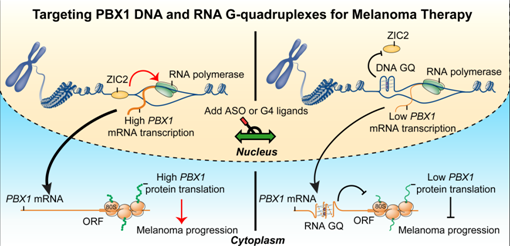Melanoma is one of the most aggressive skin malignant tumors caused by malignant transformation of melanocytes, and its incidence is increasing year by year [1]. Although there are many treatments for melanoma, the prognosis is still poor. Therefore, it is very important to explore the development mechanism of melanoma and explore the corresponding drug treatment targets for developing effective drugs for treating melanoma and improving the clinical efficacy of melanoma.
Pre-B-cell leukemia homeobox gene (PBX1) is an important transcription factor that regulates many biological processes. In recent years, more and more evidences have shown that the disorder of PBX1 is related to the occurrence of tumor, poor prognosis and drug resistance [2]. The study found that the expression of PBX1 increased in melanoma cells, and overexpression of PBX1 could significantly promote the growth of melanoma cells [3]. However, the clinical effect of PBX1 on melanoma and the molecular mechanism of PBX1 in the occurrence and development of melanoma are still unclear.
Recently, Professor Liu Jinyu of the School of Public Health of Jilin University, Professor Gao Xinghua of China Medical University and Professor Gao Hongwen of the Second Hospital of Jilin University jointly published a research paper entitled "G-quadrupexes folding media downregulation of PBX1 expression in melanoma" in the Journal of Signal Transmission and Targeted Therapy (IF=38). This study found that small molecular compounds or antisense oligonucleotides (ASO) targeting PBX1 promoter and transcript with special secondary structure of nucleic acid can effectively inhibit the development of melanoma, suggesting that PBX1 can be used as a new melanoma treatment target for the development of anti-melanoma drugs.
The team first found that PBX1 was highly expressed in melanoma tissue, and its high expression was significantly positively correlated with the poor prognosis of melanoma patients. In vivo and in vitro functional experiments found that PBX1 can activate NF- κ B signal pathway promotes the development of melanoma, indicating that PBX1 plays the role of oncogene in melanoma, and can be used as a potential therapeutic target and prognostic marker for melanoma.
G-quadruplex structure (G4s) is a four-stranded nucleic acid structure formed in guanine-rich DNA or RNA chain, which plays an important role in regulating the biological process of DNA and RNA, and G4s is widely distributed in the promoter region and transcript of human oncogenes, and is gradually becoming the focus and focus of tumor pathobiology research. It is worth noting that the content of G in the promoter and transcript of PBX1 is extremely rich, suggesting that G4s may be formed in the promoter and transcript of PBX1 and participate in the regulation of the biological function of PBX1, so it is very likely to become an important target for the development of new anti-tumor drugs.
Through bioinformatics and cell biology experiments, the research team found that there was a highly conserved G4s motif in the promoter region and transcript of PBX1 in melanoma cells, and G4s formation would inhibit the transcription and translation of PBX1, significantly reducing the expression of PBX1 protein. Further research found that small molecular compounds TMPyP4 and PDS can bind and stabilize the G4s motif of PBX1, significantly inhibiting the growth and migration (metastasis) of melanoma cells in vitro and in vivo. Because TMPyP4 and PDS stable PBX1 transcript G4s have poor sequence specificity, the research team designed ASO specifically targeting PBX1 transcript G4s. This ASO can specifically induce the formation of PBX1 transcript G4s, and significantly inhibit the growth of melanoma in the xenotransplantation model of melanoma from patients. These important findings not only contribute to the in-depth analysis of the pathogenesis of melanoma, but also provide new clues and ideas for the prognosis of melanoma and the development of targeted nucleic acid advanced structure anticancer drugs. Sui Yutong, a doctoral student, is the first author of this thesis.


